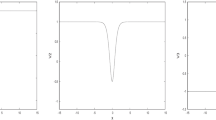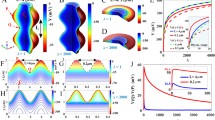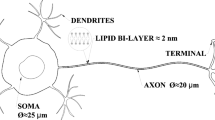Summary
-
1.
The electromechanical transduction mechanisms operating in nerve membranes are considered theoretically.
-
2.
For mechanical-to-electrical transduction (mechanical generator potentials), a model is proposed in which the surface charge on the membrane mediates stress-induced changes in the intramembrane electric field, thus opening transmembrane ion conductance channels or reducing the ion selectivity of the membrane via leak conductance pathways.
-
3.
For electrical-to-mechanical transduction (axon diameter change with excitation), an investigation into two well-known electrostatic properties of dielectrics, electrostriction and piezoelectricity, in the context of the nerve membrane is undertaken which predicts a few percent change in axon dimensions for voltage- and space-clamped axons.
Similar content being viewed by others
References
Abraham-Shrauner, B. (1975). Generalized Gouy-Chapman potential of charged phospolipid membranes with divalent cations.J. Math. Biol. 2333–339.
Adams, E. P. (1911). On electrostriction.Phil. Mag. 22889–900.
Armstrong, C. M., and Bezanilla, F. (1973). Currents related to movement of the gating particles of the sodium channels.Nature 242459–461.
Bezanilla, F., White, M. M., and Taylor, R. E. (1982). Gating currents associated with potassium channel activation.Nature 296657–659.
Bockris, J. O'M, and Reddy, A. K. N. (1970).Modern Electrochemistry, Plenum Press, New York.
Bryant, S. H., and Tobias, J. M. (1955). Optical and mechanical concomitants of activity in carcinius nerve.J. Cell Comp. Physiol. 4671–95.
Cady, W. G. (1946).Piezoelectricity, McGraw-Hill, New York.
Coakley, W. T., Bater, A. J., and Deeley, J. O. T. (1978). Vesicle production on heated and stressed erythrocytes.Biochim. Biophys. Acta 512318–330.
Cohen, L. B. (1973). Changes in neuron structure during action potential propagation and synaptic transmission.Physiol. Rev. 53373–418.
Cohen, L. B., and Keynes, R. D. (1971). Changes in light scattering associated with the action potential in crab nerves.J. Physiol. (Lond.) 212259–275.
Cohen, L. B., Hille, B., Keynes, R. D., Landowne, D., and Rojas, E. (1971). Analysis of the potential-dependent changes in optical retardation in the squid giant axon.J. Physiol. (Lond.) 218205–237.
Cohen, L. B., Keynes, R. D., and Landowne, D. (1972). Changes in axon light scattering that accompany the action potential: Current dependent components.J. Physiol. (Lond.) 224727–752.
Cole, K. S. (1968).Membranes, Ions, and Impulses, University of California Press, Berkeley.
Diamond, J., Gray, J. A. B., and Inman, D. R. (1958). The relation between receptor potentials and the concentration of sodium ions.J. Physiol. (Lond.) 142362–364.
Edwards, C., Terzuolo, C. A., and Washizu, Y. (1963). The effect of changes of the ionic environment upon an isolated crustacean sensory neuron.J. Neurophysiol. 26948–957.
Elul, R. (1967). Fixed charge in the cell membrane.J. Physiol. (Lond.) 189351–356.
Evans, E. A., and Skalak, R. (1979). Mechanics and thermodynamics of biomembranes.Crit. Rev. Bioeng. 3181–418.
Ganot, G., Wong, B. S., Binstock, L., and Ehrenstein, G. (1981). Reversal potentials corresponding to mechanical stimulation and leakage current inMyxicola giant axons.Biochim. Biophys. Acta. 649487–491.
Gilbert, D. C., and Ehrenstein, G. (1969). Effect of divalent cations on potassium conductance of squid axons: Determination of surface charge.Biophys. J. 9447–463.
Goldman, D. E. (1943). Potential, impedance, and rectification in membranes.J. Gen. Physiol. 2737–60.
Goldman, D. E. (1965). The transducer action of mechanoreceptor membranes.Symp. Quant. Biol. 3059–68.
Grahame, D. C. (1947). The electrical double layer and the theory of electrocapillarity.Chem. Rev. 41441–501.
Gross, D. J., and Williams, W. S. (1978). Piezoelectric theory of electromechanical effects in nerve. Paper TU-AM-F15 given at the 22nd Annual Meeting of the Biophysical Society, Washington, D.C.
Hermans, P. G. (1949). Gels. InColloid Science, Vol. II (Kryut, H. R., Ed.), Elsevier, New York, pp. 483–651.
Hill, B. C., Schubert, E. D., Nokes, M. A., and Michelson, R. P. (1977). Laser interferometer measurement of changes in crayfish axon diameter concurrent with action potential.Science 196426–428.
Hill, D. K. (1950). The volume change resulting from stimulation of a giant nerve fiber.J. Physiol. (Lond.) 111304–327.
Hochmuth, R. M. (1982). Solid and liquid behavior of red cell membrane.Ann. Rev. Biophys. Bioeng. 1143–55.
Hochmuth, R. M., Mohandas, N., and Blackshear, P. L., Jr. (1973). Measurement of the elastic modulus for red cell membrane using a fluid mechanical technique.Biophys. J. 13747–762.
Hodgkin, A. L. (1951). The ionic basis of electrical activity in nerve and muscle.Biol. Rev. 26339–409.
Iwasa, K., and Tasaki, I. (1980). Mechanical changes in squid giant axon associated with production of action potentials.Biochem. Biophys. Res. Comm. 951328–1331.
Iwasa, K., Tasaki, I., and Gibbons, R. C. (1980). Swelling of nerve fibers associated with action potentials.Science 210338–339.
Jackson, J. D. (1975).Classical Electrodynamics, John Wiley and Sons, New York.
Julian, F. J., and Goldman, D. E. (1962). The effects of mechanical stimulation on some electrical properties of axons.J. Gen. Physiol. 46297–313.
Junge, D. (1976).Nerve and Muscle Excitation, Sinauer Associates, Sunderland, Mass.
Kemble, E. C. (1916). Notes on the end effect in the electrostriction of cylindrical condensers.Phys. Rev. 7614–624.
Landau, L. D., and Lifshitz, E. M. (1960).Electrodynamics of Continuous Media, Pergamon Press, Oxford.
Loewenstein, W. R., Terzuolo, C. A., and Washizu, Y. (1963). Separation of transduction and impulsegenerating processes in sensory receptors.Science 1421180.
McLaughlin, S. L. (1977). Electrostatic potentials at membrane-solution interfaces.Curr. Top. Memb. Transp. 971–144.
McLaughlin, S., and Poo, M. (1981). The role of electro-osmosis in the electric-field-induced movement of charged macromolecules on the surfaces of cells.Biophys. J. 3485–93.
Miller, C. (1982). Coupling of water and ion fluxes in a K+-selective channel of sarcoplasmic reticulum.Biophys. J. 38227–230.
Obara, S. (1968). Effects of some organic cations on generator potential of crayfish stretch receptor.J. Gen. Physiol. 52363–386.
Rojas, E., and Atwater, I. (1968). An experimental approach to determine membrane charges in squid giant axons.J. Gen. Physiol. 51131s-135s.
Rojas, E., and Keynes, R. D. (1975). On the relation between displacement currents and activation of the sodium conductance in the squid giant axon.Phil. Trans. Roy. Soc. (Lond.) B 270459–482.
Singer, S. J., and Nicholson, G. L. (1972). The fluid mosaic model of the structure of cell membranes.Science 175720–731.
Stepanov, K. A. (1968). Shortening of the frog sciatic nerve on stimulation.Biophysics 13634–636.
Stratton, J. A. (1941).Electromagnetic Theory, McGraw-Hill, New York.
Tasaki, I., and Iwasa, K. (1980). Shortening of nerve fibers associated with propagated nerve impulse.Biochem. Biophys. Res. Comm. 94716–720.
Tasaki, I., Iwasa, K., and Gibbons, R. C. (1980). Mechanical changes in crab nerve fibers during action potential.Japan. J. Physiol. 30897–905.
Webb, W. W. (1981). Luminescence measurements of macromolecular mobility.Ann. N.Y. Acad. Sci. 366300–314.
Wells, J. B., and Goldman, D. E. (1981). Membrane potential changes during stretch in squid giant axons.Biophys. J. 33:91a.
White, S. H. (1974). Comments on “Electrical breakdown of bimolecular lipid membranes as an electromechanical instability.”Biophys. J. 14155–158.
Yantorno, R. E., Takashima, S., and Mueller, P. (1982). Dipole moment of alamethicin as related to voltage-dependent conductance in lipid bilayers.Biophys. J. 38105–110.
Author information
Authors and Affiliations
Rights and permissions
About this article
Cite this article
Gross, D., Williams, W.S. & Connor, J.A. Theory of electromechanical effects in nerve. Cell Mol Neurobiol 3, 89–111 (1983). https://doi.org/10.1007/BF00735275
Received:
Revised:
Accepted:
Issue Date:
DOI: https://doi.org/10.1007/BF00735275




